AFMA - June 2013 - Arizona Food Marketing Alliance
AFMA - June 2013 - Arizona Food Marketing Alliance
AFMA - June 2013 - Arizona Food Marketing Alliance
You also want an ePaper? Increase the reach of your titles
YUMPU automatically turns print PDFs into web optimized ePapers that Google loves.
Presorted Standard<br />
U.S. Postage<br />
PAID<br />
San Dimas, CA<br />
Permit No. 410<br />
<strong>June</strong> <strong>2013</strong>
ARIZONA FOOD INDUSTRY<br />
JOURNAL<br />
JOURNAL<br />
JUNE <strong>2013</strong><br />
BOARD OF DIRECTORS<br />
OFFICERS<br />
Jim Tooms, IGW L.L.C. - Chairman<br />
Jeff Nelson, Co-Sales Company - 1st Vice Chairman<br />
Doug Sanders, Sprouts Farmers Market - 2nd Vice Chairman<br />
Edward “Trey” Basha, Bashas’- 3rd Vice Chairman<br />
Geoff Stickler, Express <strong>Food</strong>s – Treasurer<br />
DIRECTORS<br />
Frank Cannistra, Safeway<br />
Joe Cotroneo, Crescent Crown Distributing<br />
Shane Dorcheus, Albertsons L.L.C.<br />
Arnott Duncan, Duncan Family Farms<br />
Clint Hickman, Hickman’s Family Farms<br />
Ray Kruckner, 7-Eleven<br />
Ken Kuwahara, Fry’s <strong>Food</strong> Stores<br />
Mark Miller, Hensley<br />
Mitzi Montoya, ASU<br />
Don Olsen, Olsens IGA<br />
Rick Provenzano, Ranch Markets<br />
Todd Schlief, Nestlé DSD<br />
T.J. Shope, Shope’s IGA<br />
Bette Taylor, <strong>Food</strong>town IGA<br />
Tim Thomas, The <strong>Arizona</strong> Republic<br />
PRESIDENT - TIM MCCABE<br />
FEATURES<br />
CONTENTS<br />
Shamrock... Real. Fresh. Ideas. ..................................................................12<br />
Nestlé Waters Provides Superior Levels of Service ........................................16<br />
COLUMNS<br />
Around <strong>Arizona</strong> History ..........................................................................8<br />
www.commentary..................................................................................10<br />
DEPARTMENTS<br />
Industry & Government ............................................................................6<br />
WORTH A LOOK<br />
Bag Central Statiion ..................................................................................18<br />
Names in the News ..................................................................................20<br />
Day at the Capitol......................................................................................21<br />
Summer Golf Classic..............................................................................23-24<br />
<strong>AFMA</strong> STAFF<br />
Debbie Roth - General Manager<br />
Raynetta Hughes - Administrative Coordinator<br />
ACS STAFF<br />
Dan Tennessen - Director<br />
Greg Colyar - Field Agent<br />
Judy Lettow - Customer Care/Office Manager<br />
JOURNAL STAFF<br />
Debbie Roth - Editor<br />
Lisa Schnebly Heidinger - Feature Writer<br />
Jim Marshall - Photographer<br />
iMagdesign - Graphic Design<br />
Layton Printing - Printer<br />
ADVERTISERS<br />
Anheuser-Busch................................2<br />
<strong>Arizona</strong> Lottery................................5<br />
Blue Bunny....................................22<br />
Clear Channel ..............................22<br />
Coke ..............................................4<br />
Crescent Crown ............................19<br />
Dreyer’s........................................11<br />
MillerCoors ..................................21<br />
Shamrock ......................................9<br />
ARIZONA FOOD MARKETING ALLIANCE<br />
120 E. PIERCE ST., PHOENIX, AZ 85004<br />
602.252.9761 • FAX: 602.252.9021<br />
DROTH@<strong>AFMA</strong>AZ.ORG<br />
WWW.<strong>AFMA</strong>AZ.ORG<br />
ANNUAL SUBSCRIPTION $50<br />
ON THE COVER<br />
Left to Right:<br />
Pam Crist – Brand Manager<br />
Jim Yurek – Vice President of Dairy Sales<br />
Blake Atkinson – Brand Manager<br />
Sandy Kelly – Senior Director of <strong>Marketing</strong><br />
Mark Stroh – Director of Trade and Category Sales
INDUSTRY & GOVERNMENT<br />
…. a summary of the issues that affect your business.<br />
“Nearly all men can stand adversity, but if you want to test a man's character, give him power.”<br />
—Abraham Lincoln<br />
BEVERAGES: <strong>2013</strong><br />
Soft Drink Volume and Share Decline<br />
The U.S. liquid refreshment beverage market grew by 1 percent in<br />
2012, according to newly released preliminary data from Beverage<br />
<strong>Marketing</strong> Corp. This marks a third year of growth after two consecutive<br />
declining years. It also represents faster growth than occurred the year<br />
before. Total liquid refreshment beverage volume approached 29.8 billion<br />
gallons in 2012.<br />
Carbonated soft drinks remained by far the biggest category, but lost both<br />
volume and market share during 2012. Volume slipped by 1.8 percent from<br />
13.6 billion gallons in 2011 to 13.3 billion gallons in 2012, which lowered their<br />
market share to less than 45 percent. While the segment faltered, certain soda<br />
trademarks, such as Coke Zero and Dr. Pepper, did achieve growth. According<br />
to published reports, the soda industry has seen declines since 2005, but<br />
2012’s soda consumption figures represent a 26-year low.<br />
Reports speculate that soda’s decline stems from health advocates,<br />
who point to soda as a cause of the obesity epidemic. Soda companies<br />
won’t be discouraged, though, as The Coca-Cola Co. has jumped into the<br />
obesity debate with ads that tout the company’s efforts in improving its<br />
products. In its “Coming Together” commercial, the Atlanta-based<br />
company emphasizes its philosophy of bringing people together and then<br />
claims it has reduced calories per serving in its drinks by an average of 22<br />
percent due to smaller pack sizes and low- and no-calorie versions of its<br />
drinks. A statement that “all calories count” ends the commercial,<br />
suggesting that all industries and consumers share the blame for obesity.<br />
However, reactions from New York Mayor Michael Bloomberg’s recent<br />
attempt to ban large sodas at restaurants—backed by some media voices,<br />
such as CNN’s opinion piece, “Banning Large Sodas is Legal and<br />
Smart”—have overshadowed the industry’s efforts to ease concerns over<br />
sugar content. Negative attention from health and wellness organizations—<br />
like the Harvard School of Public Health saying the drinks cause kidney<br />
damage and cancer in addition to obesity—probably won’t help the<br />
industry’s <strong>2013</strong> figures either.<br />
Other segments show growth<br />
Premium beverages, such as ready–to–drink (RTD) tea, coffee and<br />
energy drinks, advanced during 2012. Energy drinks moved forward faster<br />
than all other segments with a 14.3 percent volume increase in 2012, even<br />
though the segment is a relatively small share of the industry. The only<br />
liquid refreshment beverage types with smaller shares of volume were RTD<br />
coffee, which charted the second fastest surge, growing by 9.5 percent, and<br />
value-added water, which contracted.<br />
RTD tea grew by nearly 5 percent in 2012.<br />
“Beverages showed gathering strength in 2012,” said Michael C.<br />
Bellas, chairman and CEO of Beverage <strong>Marketing</strong> Corp. “While an<br />
improving economy remains the key impetus for beverage category success,<br />
the vitality of premium products like energy drinks and RTD coffee shows<br />
that Americans’ thirst for both functional and fun products is strong.”<br />
New York City–based Beverage <strong>Marketing</strong> Corp. is the leading<br />
research, consulting and financial services firm dedicated to the global<br />
beverage industry.<br />
Coffee consumption increasing<br />
More Americans are turning to coffee than in previous years,<br />
according to a report from the Drinks Business Review. A market research<br />
study by the National Coffee Association found that coffee consumption<br />
increased by 5 percent from the previous year.<br />
Daily consumption has not changed and stays at 63 percent, but those<br />
reporting drinking coffee at least once a week increased to 75 percent, the<br />
report says.<br />
Thirteen percent of the U.S. population drinks coffee from a<br />
single-cup brewer, while drip coffee use has decreased from 43 percent<br />
to 37 percent.<br />
The study also found that those in the 18-39 age bracket drink more<br />
espresso-based drinks than seniors 60 and older, but consumption by the<br />
youngest participants (18-24) declined nine percentage points to 41<br />
percent, while consumption for seniors 60 and older rose five percentage<br />
points to 76 percent, the report says.<br />
NORTH AMERICAN POS MARKET<br />
REACHES $2B<br />
Almost three in 10 (28%) of North American retailers plan to adopt<br />
mobile POS technology by the end of the year, according to a new study<br />
from IHL Group.<br />
Results of “Mobile POS: Hype to Reality” also indicate that 45% of all<br />
tablet POS shipments go to specialty retailers, mobile POS solutions will<br />
cannibalize about 12% of traditional retail POS shipments by 2016 and more<br />
than 85% of larger retailers say that in the next three years mobile POS<br />
systems will complement, rather than replace, traditional POS systems.<br />
The study also indicates that 33% of retailers are not planning to<br />
deploy mobile POS technology in the next three years.<br />
“The vast majority of retailers are taking a slow and methodical<br />
approach to the use of mobile for POS,” said Greg Buzek, president, IHL<br />
Group. “There are key operational issues in device and merchandise<br />
security, cash handling, payments, bags, customer service levels and traffic<br />
flow that must be worked through or the use of the devices will be<br />
disruptive in a negative way for retailers."<br />
FOOD RETAILERS MARK BETTER<br />
BIZ LANDSCAPE<br />
Sixty percent of food retailers experienced higher customer counts<br />
and 46 percent saw stronger transaction sizes in fiscal 2012 versus the prior<br />
year, a new <strong>Food</strong> <strong>Marketing</strong> Institute (FMI) financial and business review<br />
survey has found. For <strong>2013</strong>, food retailers remain upbeat, with 58 percent<br />
Page 6 • <strong>Arizona</strong> <strong>Food</strong> Industry Journal • <strong>June</strong> <strong>2013</strong>
expecting business conditions to get better and 64 percent anticipating that<br />
the average shopping basket will continue to grow.<br />
Conducted by San Antonio-based 210 Analytics, LLC, the <strong>Food</strong><br />
Retailing and Financial Business Review Survey contains a financial<br />
review of fiscal 2012, a business environment and operational review for<br />
2012 and <strong>2013</strong>, and shrink metrics and reporting. <strong>Food</strong> retailers’<br />
confidence in the business environment and their financial performance<br />
paralleled the slow but steady improvements across such key economic<br />
indicators as the gross domestic product, unemployment rates and the<br />
consumer confidence index.<br />
The survey delved into the issues of food retail staffing, salaries and<br />
benefits, health care costs and reform, and operational shrink. Among the<br />
key findings:<br />
● Staffing: The vast majority of survey respondents are adding or<br />
maintaining corporate and store associate levels, after several years of staff<br />
reductions. The <strong>2013</strong> outlook is for greater levels of hiring and even less<br />
staff reduction.<br />
● Salaries and Benefits: Nearly two-thirds of respondents raised<br />
hourly pay in 2012, and 74 percent gave raises for salaried associates.<br />
Retailers maintained the status quo on most benefits, with employee<br />
training being the most likely area of higher budget allocations.<br />
● Health Care Costs and Reform: With costs rising year-over-year<br />
for the majority of retailers, 77 percent of respondents said they needed to<br />
pass along part of the cost increases to employees. In regard to the impact<br />
of health care reform legislation, 88 percent said it will hike up health care<br />
costs in <strong>2013</strong>, and 96 percent believed it will further raise expenses in 2014.<br />
According to the survey, the most common actions taken to control health<br />
care coverage costs are encouraging healthy lifestyles and introducing plan<br />
modifications to lower costs.<br />
● Operational Shrink: While best-of-class retailers averaged 1.2<br />
percent total store shrink, the average among all respondents was 2.9<br />
percent. Better tracking, analysis and reporting were the top ways that<br />
retailers said they were able to lower shrink.<br />
D.C. CIRCUIT COURT OF APPEALS STRIKES<br />
DOWN NLRB’S POSTER RULE<br />
The United States Court of Appeals for the D.C. Circuit held that the<br />
National Labor Relations Board (NLRB) rule requiring employers to post<br />
notices regarding employees’ right to unionize was invalid.<br />
Many of you will recall that back in 2011, the NLRB issued a rule<br />
requiring nearly all private employers (union or non-union) to post an<br />
NLRB-designated notice informing employees of their right to unionize<br />
under Section 7 of the National Labor Relations Act (NLRA). This<br />
requirement was held to be invalid by a South Carolina federal district court<br />
last year, and the NLRB has been prevented from implementing this rule<br />
pending the outcome of that appeal, which currently is pending in the<br />
Fourth Circuit Court of Appeals.<br />
In the decision, National Association of Manufacturers v. N.L.R.B.,<br />
the D.C. Circuit also held that the NLRB could not through its rulemaking<br />
authority require employers to post this notice. The court reasoned that<br />
employers have a constitutional right to engage in speech about<br />
unionization, provided that it is not coercive or threatening. This First<br />
Amendment right is echoed in Section 8(c) of the NLRA, which<br />
precludes the NLRB from finding such non-coercive speech to be an<br />
unfair labor practice or evidence of an unfair labor practice. The court<br />
held that these rights include the right to decide not to disseminate such<br />
speech, and, therefore, the NLRB could not require employers to post<br />
right-to-unionize notices.<br />
It is anticipated that the NLRB will appeal this decision to the U.S.<br />
Supreme Court. But, for now, you can keep the NLRB “Notice of Rights”<br />
poster resting comfortably in a file drawer. (Note that federal contractors<br />
are still required to post a similar Department of Labor “Notice of Rights”<br />
poster which was issued by that agency back in May of 2010.)<br />
NEW RULES FOR LABELING MEAT GO<br />
INTO EFFECT IN U.S.<br />
Shoppers in the U.S. will soon have more information about where<br />
their meat comes from after new federal labeling rules went into effect.<br />
The rules require labels on steaks, ribs and other cuts of meat to say<br />
where the animal was born, raised and slaughtered. Earlier U.S.<br />
Department of Agriculture rules only required that countries of origin to<br />
be noted, so a package might say "Produce of U.S. and Canada." Now, the<br />
label will specify "Born in Canada, raised and slaughtered in the<br />
United States."<br />
The new rules apply only to cuts of meat such as steaks and roasts,<br />
not to ground meat.<br />
The USDA has required country of origin labels on seafood since<br />
2005 and on meat and other products since 2009. The new rules for meat<br />
are meant to bring the U.S. in line with World Trade Organization<br />
standards after the organization determined the old labels discriminated<br />
against livestock imported from Canada and Mexico.<br />
President Barack Obama's administration had asked the meat<br />
industry in 2009 to voluntarily provide the additional information on<br />
labels. The new requirements come after the WTO's appeals body in <strong>June</strong><br />
upheld the organization's earlier decision.<br />
The meat industry and grocery stores have protested the changes,<br />
saying they are a hassle and could lead to higher prices. The National<br />
Grocers Association issued a statement expressing its "strong frustration"<br />
over what it sees as “unnecessary" regulation.<br />
"The costs of this new change will far exceed the benefits intended<br />
and will result in no meaningful consumer benefits," the group's<br />
president and CEO, Peter Larkin, said in a statement. "Congress must<br />
take action now and create a legislative fix."<br />
The USDA estimates the labeling change will cost somewhere<br />
between $53.1 million and $192.1 million to put in place. The National<br />
Grocers Association said it expected it to cost at least $100 million as<br />
companies buy new signs, labels and labeling machines.<br />
Cargill, one of the nation's largest meatpackers, protested the rules<br />
in a letter sent previously to the USDA. It said the U.S. is heavily<br />
dependent on cattle born elsewhere but sent to feedlots and<br />
slaughterhouses here, and that was more true after last year's drought<br />
dropped the U.S. herd to its lowest level in decades.<br />
Cargill said it had already idled a meatpacking plant in Texas<br />
because too few cattle were available and the problem would only get<br />
worse as imported cattle became less attractive to companies seeking to<br />
avoid the need for multiple labels.<br />
The National Cattlemen's Beef Association said it didn't think the<br />
rules would satisfy Canada and Mexico, the nation's top trading partners,<br />
and it feared retaliation with taxes or other restrictions on U.S. beef.<br />
"While trying to make an untenable mandate fit with our<br />
international trade obligations, USDA chose to set up U.S. cattle producers<br />
for financial losses," the association said in a statement. "Moreover, this<br />
rule will place a greater record-keeping burden on producers, feeders and<br />
processors through the born, raised and harvested label."<br />
The rules have had support from other farmers' organizations, along<br />
with consumer and environmental groups. Nearly 230 signed an April<br />
letter to Agriculture Secretary Tom Vilsack, including the National<br />
Farmers Union, U.S. Cattlemen's Association and Center for <strong>Food</strong> Safety.<br />
The National Farmers Union issued a statement Thursday praising<br />
the Obama administration for "providing more information on the origins<br />
of our food, instead of simply watering down the process."<br />
"Consumers want and have the right to know where their food comes<br />
from," it added.<br />
The new labels will begin showing up gradually in grocery stores.<br />
Meat processed or packaged before Thursday can still be sold with older<br />
labels, and the USDA is allowing meat companies to use up any of the<br />
older labels they already had printed.<br />
●<br />
<strong>June</strong> <strong>2013</strong> • <strong>Arizona</strong> <strong>Food</strong> Industry Journal • Page 7
Around <strong>Arizona</strong> History<br />
“You need your food, you need your water, and you need your history!”<br />
A Profile History of Dairy Farming<br />
By Jack L. August, Ph.D.<br />
I<br />
n the United States, dairy products have a deep and rooted place in the retail<br />
food industry. Today, the top five dairy states are, in order by total milk<br />
production; California, Wisconsin, Idaho, New York, Michigan, and<br />
Pennsylvania. For example, Pennsylvania, the nation’s fifth largest producer, has<br />
8,500 farms with 555,000 dairy cows, yielding annual revenues of about$1.5<br />
billion. Herd size in the US varies between 1,200 on the West Coast and<br />
Southwest, where large farms are commonplace, to roughly 50 in the Northeast,<br />
where land-base is a significant limiting factor to herd size. The average herd<br />
size in the U.S. is about one hundred cows per farm.<br />
For centuries<br />
dairy farming has been a<br />
small part of diverse<br />
farming operations. In<br />
the last century larger<br />
farms specializing in<br />
dairy production<br />
emerged. The<br />
development of dairy farming-only operations took place where either a large<br />
amount of milk was required for production of more durable dairy products, like<br />
cheese and butter, or where there existed a substantial market of people with<br />
cash to buy milk, but no cows of their own.<br />
Historically, centralized dairy farming developed around villages and<br />
cities, where residents were unable to have cows of their own due to a lack of<br />
grazing land. Farmers made extra money by having additional animals and<br />
selling the milk in town. Typically dairy farmers filled barrels with milk in the<br />
morning and brought it to market on a wagon. Until the late 19th century<br />
milking was done by hand. In the United States, however, several large dairy<br />
operations existed in some northeastern states and in the west that involved as<br />
many as several hundred cows, but an individual milker could not be expected<br />
to milk more than a dozen cows a day. In effect, until the twentieth century<br />
smaller operations predominated.<br />
The earliest milking machines were extensions of the traditional milking<br />
pail. These earliest devices fit on top of a regular milk pail and sat on the floor<br />
beneath the cow. After a cow was milked, the bucket would be dumped into a<br />
holding tank. This developed into what was called the Surge hanging milker.<br />
Prior to milking a cow, a large wide leather strap called a surcingle was put<br />
around the cow, across its lower back. The milker device and collection tank<br />
hung underneath the cow from the strap. This innovation allowed the cow to<br />
move around naturally during the milking process.<br />
Two more inventions helped revolutionize the milking process. The first of<br />
these, the milk pipeline, featured a permanent milk-return pipe and a second vacuum<br />
pipe that encircled the barn or milking parlor above the rows of cows, with quickseal<br />
entry ports above each cow. By eliminating the need for the milk container, the<br />
milking device shrank in size and weight to the point where it could<br />
hang under the cow. The milk was pulled up into the milk-return<br />
pipe by the vacuum system, and then flowed by gravity to the milk<br />
house vacuum-breaker that put the milk in the storage tank.<br />
The pipeline system greatly reduced the physical labor of<br />
milking since the farmer no longer needed to carry around huge<br />
heavy buckets of milk from each cow. Moreover, the pipeline<br />
allowed barn length to keep increasing and expanding, but after a<br />
point farmers started to milk the cows in large groups, filling the<br />
barn with one-half to one-third of the herd, milking the animals, and<br />
then emptying and refilling the barn. As herd sizes continued to<br />
increase, this dairy farm institution evolved into the more efficient<br />
milking parlor.<br />
Page 8 • <strong>Arizona</strong> <strong>Food</strong> Industry Journal • <strong>June</strong> <strong>2013</strong><br />
The other innovation in<br />
milking focused on mechanizing<br />
the milking parlor to<br />
maximize the number of cows<br />
per operator. This further<br />
streamlined the milking process to permit cows to be milked as if on an assembly<br />
line, and to reduce physical stress on the farmer by putting the cows on a<br />
platform slightly above the person milking the cows. In the 1980s and 1990s,<br />
robotic milking systems were developed and introduced in the United States and<br />
throughout Europe. Thousands of these systems are now in operation and in<br />
these systems the cow has a high degree of autonomy to choose her time of<br />
milking. These systems are generally limited to intensively managed systems<br />
although research continues to match them to the requirements of grazing cattle<br />
and to develop sensors to detect animal health and fertility automatically.<br />
Other technological innovations were essential in the history of dairy<br />
product production. When windmills and well pumps were invented, one of its<br />
first uses on the farm--besides providing water for animals--was for cooling<br />
milk, to extend the storage life before being transported to the town market. And,<br />
when refrigeration first arrived in the 19th century the equipment was initially<br />
used to cool cans of milk. Soon, “Ice banks” appeared; a type of bulk milk<br />
cooler. This was a double wall vessel with evaporator coils and water located<br />
between the walls at the bottom and sides of the tank. A small refrigeration<br />
compressor was used to remove heat from the evaporator coils. Ice eventually<br />
built up around the coils, until it reached a thickness of about three inches<br />
surrounding each pipe, and then the cooling system shut down.<br />
This cooling method worked well for smaller dairies. It was, however, fairly<br />
inefficient and was unable to meet the increasingly higher cooling demand of<br />
larger milking parlors. In the mid-1950s direct expansion refrigeration was first<br />
applied directly to the bulk milk cooler. This type of cooling utilized an evaporator<br />
built directly into the inner wall of the storage tank to remove heat from the milk.<br />
Direct expansion was able to cool milk at a much faster rate than early ice bank<br />
type coolers and is still the primary method for bulk tank cooling today.<br />
Today, there are 65,000 dairy farms in the United States. In <strong>Arizona</strong><br />
producers provide enough product, not only for the state’s growing market, but<br />
also for retailers beyond the state’s borders. In fact dairies are <strong>Arizona</strong>’s highest<br />
grossing agricultural sector. Current revenue from the state's dairy industry<br />
totals about $871 million annually. Approximately 177,000 milk cows work in<br />
about 180 dairies across the state. Like farms and cattle ranches many of these<br />
are family owned. <strong>Arizona</strong> is ranked number twelve in the nation for milk<br />
production. In 2012, <strong>Arizona</strong> cows produced almost 400 million pounds of milk<br />
for cheese, yogurt, ice cream, and other dairy products for a global market. This<br />
important sector of our agricultural economy will continue to grow and<br />
doubtlessly remain one of the bulwarks of the retail food industry. ●<br />
Dr. Jack L. August, Jr. is a Visiting Scholar in Legal History at Snell & Wilmer L.L.P. He<br />
is a former Fulbright Scholar, National Endowment for the Humanities Research Fellow, and<br />
Pulitzer Prize nominee for his volume, Vision in the Desert: Carl Hayden and Hydropolitics<br />
in the American Southwest (Ft. Worth: TCU Press, 1999). Dr. August is the author of numerous<br />
books on the history of the New American West and has taught at the University of Houston,<br />
University of North British Columbia, and Northern <strong>Arizona</strong> University where his courses<br />
focused on the American West and environmental history.
www.commentary<br />
By Phil Hawkes<br />
I am in a pickle!<br />
I want to write about pickles, but there is so<br />
much information about them, I don’t know where<br />
to start. As you probably know, being in a pickle means<br />
you’re in a quandary, a dilemma or some other difficult<br />
situation. Shakespeare actually wrote about someone in a pickle<br />
around 1610 in The Tempest. The character Trinculo says, “ I have been<br />
in such a pickle since I saw you last…” But why “in a pickle,” you ask Well it<br />
has to do with the similarity to the situation a cucumber finds itself in when it’s<br />
submerged in salt and vinegar solution and mixed up with spices and then<br />
marinates and ferments into a pickle.<br />
Pickles go back a lot further than Shakespeare’s time. The Mesopotamians<br />
were making pickles in 250 B.C. Not sure how they know that, but it is safe to say<br />
that pickling was invented more to preserve food than it was to have something to<br />
go with a sandwich. Pickles have played a role throughout history. Columbus<br />
credited part of the reason for the success of his 1492 voyage to the pickles he<br />
rationed to his crew to prevent scurvy. He actually grew cucumbers in Haiti so he<br />
would have a new supply of pickles for the trip back to Europe. The fellow who<br />
named the place Columbus discovered was Amerigo Vespucci. He made his<br />
fortune as a pickle merchant. Napoleon offered a reward for whoever came up<br />
with the best pickles and pickling process for his armies. And during WWII, 40<br />
percent of the entire pickle production went to the ration kits of U.S. armed forces.<br />
There are three prominent pickle varieties. The sweet pickle is aptly named.<br />
One of the most popular sweet pickle types, though, bread and butter pickle slices<br />
has nothing to do with either bread or butter. Dill pickles are twice as popular as<br />
sweet pickles. And dill pickles have a number of different styles and flavors, like<br />
kosher, genuine and polish varieties. Americans like their pickles with those little<br />
bumps on them. They are referred to as warts in the pickle business. I don’t think<br />
that’s such a good choice of words. Europeans like their pickles to be smooth on<br />
the outside. Pickles are generally thought of as a vegetable, but they are<br />
technically a fruit, as they come from a vine. More than half of the cucumbers<br />
grown in the United States are made in to pickles. And we Americans like our<br />
pickles, as we consume an average of 9 pounds of them each year. And<br />
considering that pickles have no fat and are low in calories, we can eat even more<br />
and not feel guilty about it.<br />
There are big brands of pickles, like Vlasic and Heinz that are in every<br />
supermarket in the country. There are numerous small, cottage industry pickle<br />
producers in practically every state. I can’t figure out why they all personalize<br />
their pickle brands. A few examples include:<br />
● Miss Jenny’s Pickles in North Carolina missjennyspickles.com<br />
● Rick’s Pickles in New York rickspicks.com<br />
● Britt’s Pickles in Washington brittsliveculturefoods.com<br />
● Wickle’s Pickles in Alabama wicklespickles.com<br />
● Grillo’s Pickles in Connecticut grillospickles.com<br />
● Emmy’s Pickles and Jams in California emmyspicklesandjams.com<br />
● McClure’s Pickles in Michigan and New York mcclurespickles.com<br />
● Mickle’s Pickles in Massachusetts micklespickles.com<br />
● Perkin’s Pickles in Michigan perkinspickles.com<br />
● Spacey Tracy’s Pickles in New York spaceytracypickles.com<br />
● Gordy’s Pickles in Washington D.C. gordyspicklejar.com<br />
● Lynnaes’ Gourmet Pickles in Washington lynnaesgourmetpickles.com<br />
● Horman’s Pickles in New York hormansbestpickles.com<br />
● Horman’s lives by the “picklosophy”…I think therefore I pickle.<br />
There are four pickle facts and uses that you’ll be glad<br />
you learned here:<br />
1 - There are a number of things you can do with the leftover pickle juice in<br />
the jar when the pickles are gone. Think of it as being green in a new way…<br />
recycling pickle juice! It makes an excellent marinade. Put pickle juice in your<br />
favorite BBQ sauce. It adds tanginess. Mix some pickle juice with the<br />
mayonnaise that goes in your potato salad…yum. On the non-consumable side,<br />
pickle juice will remove coffee stains from the bottom of cups. And pickle juice<br />
is effective at killing weeds in the cracks of paving stones and sidewalks.<br />
2 - Atheletes have been known to drink pickle juice to prevent muscle<br />
cramps. The Philadelphia Eagles credited drinking pickle juice with helping them<br />
win a game in sweltering heat.<br />
3 - During the 1893 Chicago World’s Fair, Mr. H.J. Heinz used pickle<br />
shaped pins (above) to advertise his pickle brand. He gave out 1,000,000 pickle<br />
pins!<br />
4 - The popularity of Kool-Aid pickles is going virile. Empty the pickle<br />
juice from a 32 jar of whole dill pickles in to a bowl. Mix in ½ cup of sugar and<br />
two packages of Kool-Aid. Either cut in half, lengthwise or slice the pickles. Put<br />
pickles and juice mixture back in the jar and put in the refrigerator for one week.<br />
Kids love them!<br />
Lastly, two more pickle things: Next time you go to a baseball game, I hope<br />
you get to witness the perfect example of being in a pickle. In fact, the play is<br />
called a pickle. It’s when a base runner gets caught between two bases and the<br />
defenders are closing in on him by tossing the ball back and forth. And for the<br />
record, the best pickles anywhere are Bubbie’s Kosher Dill Pickles (bubbies.com)<br />
from San Francisco. They are available in most supermarkets.<br />
funtrivia.com<br />
pickleguys.com<br />
tidbitfun.com<br />
mentalfloss.com<br />
foodreference.com<br />
phrases.org<br />
●<br />
Page 10 • <strong>Arizona</strong> <strong>Food</strong> Industry Journal • <strong>June</strong> <strong>2013</strong>
Shamrock... Real. Fresh. Ideas.<br />
By Lisa Schnebly Heidinger<br />
After thirteen years at<br />
Shamrock Farms, Senior<br />
Director of <strong>Marketing</strong> Sandy<br />
Kelly says she still thinks of<br />
herself as a newbie.<br />
That’s because so<br />
many associates of this<br />
family-owned company –<br />
one of the largest familyowned<br />
and –operated dairies<br />
in the nation – have been<br />
there for 20, 30, even 40<br />
years…more than 250 of<br />
them.<br />
Sandy, a vivacious blonde with an easygoing manner, fairly beams<br />
talking about Shamrock. (She explains that Shamrock Farms, the dairy<br />
business, and Shamrock <strong>Food</strong>s, the foodservice distribution company, are<br />
under the umbrella of Shamrock <strong>Food</strong>s Company.) Ever since she was a<br />
little girl she’s known she wanted to be involved in advertising. And she<br />
says her work at Shamrock involves so much more.<br />
“From as far back as I can remember I would watch ads on TV and<br />
critique them. I’ve always known my passion. I’m so lucky to be at<br />
Shamrock, because here we get to do not just great advertising, but we get<br />
to drive product development and all areas of the marketing mix.”<br />
As a family-owned business, Shamrock gets to be as innovative, as<br />
bold, as creative as the management decides without slogging through<br />
shareholders’ timetables. This means Chairman of the Board Norman<br />
McClelland, and his son, Chief Executive Officer Kent McClelland,<br />
continue to do what Shamrock’s founder (Norman’s father, Kent’s<br />
grandfather) W.T. McClelland did: figure out what customers want, and do<br />
the best job providing it.<br />
Shamrock turned 90 years old last year -- Kelly says work has<br />
already begun on the centennial. The company is a fascinating hybrid: a<br />
Feature writer, Lisa Schnebly Heidinger<br />
interviews Sandy Kelly,<br />
Senior Director of <strong>Marketing</strong>.<br />
very traditional, familybased,<br />
caring and<br />
cooperative workplace—<br />
and<br />
an aggressive, innovative,<br />
high-tech and sustainability-focused<br />
powerhouse.<br />
On the family side,<br />
Sandy says, associates<br />
really feel like part of an<br />
extended clan whose<br />
members look out for one<br />
another. “Norman’s motto<br />
is to treat employees like family, and customers like friends. And I know<br />
people can use words like ‘family’ any- where, but people come here and<br />
they stay. They really find a home. That’s driven by the family.”<br />
Which by no means implies that the company is a folksy oldfashioned<br />
business doing things just the way grandpa did them. Few<br />
corporations are as innovative, as restless in the search for making<br />
everything already good even better. Shamrock’s Extended Shelf Life<br />
technology brought a new age to the entire dairy industry. “ESL basically<br />
means bringing the milk to a higher temperature and packaging it<br />
differently,” says Sandy. “It can stay fresh for up to 100 days.” The ESL<br />
packages are for smaller portions than a family-size jug, which reframes<br />
when people enjoy milk.<br />
Basically, it lets people see milk as playing a different role in family<br />
life. Not only poured into glasses at the breakfast table, but tossed into a<br />
school lunch, picked up at a convenience store, and available at fast food<br />
restaurants nationwide. (SUBWAY®, Arby’s and Einstein Brothers are a<br />
few of them.)<br />
Shamrock doesn’t stop there. As a member of the Milk Processors<br />
Education Program board, (famed milk mustache Got Milk Campaign),<br />
Sandy says she’s glad that her employer is constantly thinking about how<br />
Page 12 • <strong>Arizona</strong> <strong>Food</strong> Industry Journal • <strong>June</strong> <strong>2013</strong>
to make dairy a bigger part of daily life for all type of customer.<br />
One of the products she’s most excited about is Rockin’ Refuel, which<br />
is a line of protein-fortified milk beverages. Sandy explains that in our<br />
increasingly health-conscious world, this product makes perfect sense. And<br />
who would ever have thought that chocolate milk, the guilty pleasure of<br />
dairy consumers everywhere, would be vaunted as the best choice<br />
“New science about chocolate milk shows it to restore glycogen in<br />
muscles, rebuilt after tearing them down in a workout. This is the most<br />
innovative product we have at a national level right now. Milk already has<br />
protein, and calcium, so it made perfect sense.”<br />
This, then, is a sports drink without the empty calories or high number<br />
of chemicals found in soft drinks or energy drinks. With 20 grams of<br />
protein, Rockin’ Refuel creates the perfect protein-to-carbohydrate formula<br />
determined by nutrition specialists for optimum muscle recovery. By<br />
making milk part of a muscle-building beverage, and one that’s handy to<br />
grab, quick to drink, and in flavors even young athletes love, milk is as<br />
much at home at the gym as it is on a supper table. (Author’s note: bottles<br />
of chocolate, vanilla and strawberry Rockin’ Refuel brought home from the<br />
grocery the day following Sandy’s interview for an 18-year-old son<br />
disappeared that same day.)<br />
Sandy says an even leaner version of Rockin’ Refuel is headed for the<br />
shelves, with 150 calories and 20 grams of protein. People who want to be<br />
in amazing shape not only don’t have to give up dairy, but also can improve<br />
by including it in their nutrition plan. There are sugar-free options as well.<br />
Shamrock seems to have gone from a local company to a national<br />
leader without visible growing pains. Take Roxie the cow, named in 1994<br />
“She has an office,” jokes Sandy. Roxie does public appearances, is part of<br />
the Shamrock logo (on Sandy’s polo shirt) and even got her own Super<br />
Bowl commercial two years ago. Now that’s a high profile.<br />
Another key testament to the ease of growing is the wonderful retailers<br />
Shamrock collaborates with on introducing new products and promoting<br />
dairy overall. Building strong relationships here in <strong>Arizona</strong> has provided<br />
Shamrock a great foundation on how to expand nationally into new markets<br />
by creating successful retail partnerships, which is key with any new<br />
product launches.<br />
Back to the logo. Under Roxie are three words: “Real. Fresh. Ideas.”<br />
This sums up Shamrock’s commitment to associates and consumers alike.<br />
“Real” means genuine, sincere; a good start for a corporation that gave<br />
to more than 80 non-profit entities last year, and contributes more than<br />
80,000 pounds of food to local food banks. “Fresh” means dedication to<br />
safety, ensuring that every product bearing the Shamrock label is both tasty<br />
and nutritious, never compromised. It also means quality and with<br />
Shamrock owning and running its own farm and processing plant, top notch<br />
quality and above state standards and regulations are executed to ensure<br />
their products are the very best. “Ideas” keep coming, putting the company<br />
on the leading edge of innovation across the country.<br />
In fact, it is across the United States that one of Shamrock’s newest<br />
ideas is taking shape. A manufacturing facility under construction in<br />
Virginia will let Shamrock meet the demands of single serve mmmmilk<br />
distribution for consumers all over the country. In fact, because of their<br />
relentless and talented sales force, operations team and marketing<br />
department, you can now find Shamrock products in retailers, colleges,<br />
schools, foodservice establishments and more!<br />
Sandy says the Virginia Shamrock Farms facility will feature the<br />
ESL technology. “We needed more capacity, dual manufacturing<br />
capabilities to support the growing business of the single-serve bottle,<br />
and in a place that best serves national needs. So now we have a great<br />
facility here, and on the east coast.”<br />
As a good new neighbor would do, it’s donating Rockin’ Refuel to local<br />
high school athletic teams. On that note, Sandy says Rockin’ Refuel and<br />
mmmmilk in easy-to-carry bottles are on the menus at all three state universities.<br />
And the four ‘m’s in milk Just one more way Shamrock is constantly<br />
and enthusiastically sharing the love of dairy products with the public. The<br />
new, smaller containers represent a shift in the way consumers think of<br />
milk: no longer the bulky gallon jug in the refrigerator door shelf, but the<br />
same way a bottle of water, or an aluminum can of soda can be taken<br />
anywhere. Because of the national awareness of health and nutrition,<br />
Shamrock seems to have timed it perfectly.<br />
Another way Shamrock invites people to appreciate dairy products<br />
more is by touring the Stanfield Shamrock Farms. Many Tucson<br />
schoolchildren fondly recall field trips to the original Shamrock Dairy<br />
there. After the dairy cattle operation moved to just outside Maricopa in<br />
Stanfield, public and schoolchildren were once again invited to see where<br />
milk comes from before it reaches grocery cases.<br />
It’s a great blend of down-on-the-farm old-fashioned fun and<br />
education, which charms thousands of visitors every year. As soon as you<br />
board the spotted cow train, you know this tour has entertainment in mind.<br />
From the big red barn to the 10,000 cows waiting to meet visitors, the<br />
Shamrock Farms tour guides aim to please. Then there’s the 20-foot milk<br />
bottle, a maze, and a cottage cheese slide. Picnic area, snack bar, and<br />
special appearances by Roxie during special events (called the “Dairy<br />
Godmother” with a wooden spoon instead of a wand) the beloved mascot,<br />
adds to a festive experience. In addition, Shamrock has teachers’ guides on<br />
the web and downloadable lesson plans to incorporate nutrition,<br />
sustainability and agriculture into curriculum.<br />
Back to inventing new products, Sandy says coming out this summer<br />
is a line of flavored sour creams. “My favorite is the zesty jalapeño; it’s not<br />
too spicy, but it really adds to Taco Tuesday. Then we have a creamy ranch<br />
that kids can use for dip with crackers, or vegetables. And there’s a French<br />
onion. That’s always the most popular flavor. They’re all real sour cream,<br />
and all amazing.” The idea is to encourage people “dip it, mix it, top it.”<br />
Sandy’s team is already planning some tailgate events at ASU in August<br />
with the latest additions to the Shamrock Farms family.<br />
“On the family side,<br />
Sandy says, associates<br />
really feel like part of an<br />
extended clan whose<br />
members look out for one<br />
another. “Norman’s motto<br />
is to treat employees like<br />
family, and customers like<br />
friends.<br />
”<br />
Sandy Kelly,<br />
Senior Director of <strong>Marketing</strong><br />
Shamrock Farms<br />
All these things fall under the Shamrock Farms side of the business.<br />
What about Shamrock <strong>Food</strong>s That’s the foodservice distributor, which<br />
delivers products to restaurants, businesses, hospitals, foodservice facilities<br />
and industries. They have 16,000 different products, including fresh<br />
seafood, meat and produce, as well as paper goods and of course fresh<br />
dairy.<br />
Sandy says, “This was another vision of the McClelland family in the<br />
60s, to venture into the foodservice business. They were sending everything<br />
out in refrigerated trucks, so they decided to, expand to foodservice.’ That’s<br />
been a growing side of the business. We have warehouses in <strong>Arizona</strong>,<br />
Colorado, New Mexico, and most recently in California.”<br />
Shamrock <strong>Food</strong>s strives to be a collaborative partner to its customers<br />
by offering a wide array of products, menu and recipe trends, and ultimately<br />
being a solution to their business needs.<br />
So with foods besides dairy going out to businesses across the<br />
Southwest, being at the forefront of dairy as a sports drink, having created<br />
the boldest fresh packaging for milk since the cow itself, and coming up on<br />
100 years, it’s no wonder the Shamrock Farms brand has 98 percent<br />
consumer awareness… as well as Roxie the cow. It’s good to be at<br />
<strong>June</strong> <strong>2013</strong> • <strong>Arizona</strong> <strong>Food</strong> Industry Journal • Page 13
Day at the<br />
Capitol<br />
By Debbie Roth<br />
ne of the most anticipated events at the Copper Dome,<br />
<strong>AFMA</strong>’s Day at the Capitol provides Grocers with an opportunity<br />
to showcase their unique products and service offerings to the<br />
citizens of <strong>Arizona</strong> who populate the State Legislature and State<br />
Government offices.<br />
Record numbers of Staffers, Interns and Legislators stood patiently<br />
in line to sample and hear the message each company wanted to share with<br />
their “customers”. In addition to all of the sampling and give-aways<br />
provided at each exhibit, all were treated to a hotdog and brat’s luncheon<br />
topped off by an ice cream social hosted by Blue Bell Ice Cream.<br />
Grocer’s participating in this year’s event included Sprout’s Farmers<br />
Market who showcased natural and organic items; Safeway who featured<br />
consumer brands with a focus on bakery and deli items; 7-Eleven who<br />
provided private label products which included Slurpees and Iced Coffees;<br />
Fry’s <strong>Food</strong> Stores who staged a healthy corner featuring samples of trail<br />
mix, chips, health and wellness bars and juice; Bashas’/<strong>Food</strong> City/AJ’s<br />
focus was the Hometown Grocer sampling healthy snacks; Albertsons<br />
provided Diabetic Education along with healthy snacks; Hickman’s<br />
Family Farms focused on <strong>Arizona</strong> Grown Products sampling their famous<br />
hard boiled eggs and the <strong>Arizona</strong> State Lottery was on hand to explain how<br />
the Lottery impacts the state of <strong>Arizona</strong> through their many programs.<br />
Suppliers who graciously donated product for the luncheon<br />
included: Inventure <strong>Food</strong>s with a donation of Poore Bros. chips; the<br />
Johnsonville Sausage Company who provided brats for grilling and<br />
Nathan’s who provided the hotdogs; and Holsum Bakery who contributed<br />
the hotdog buns.<br />
The City of Phoenix was also in attendance in support of Bag<br />
Central Station and provided much needed trash removeal for all the<br />
exhibits. At the end of the day 640 lbs. of cardboard and debris was<br />
collected with 50% of that diverted from the landfill.Many thanks to<br />
Brewer Johnson with Sales Builders who provided the manpower and<br />
equipment for grilling the hotdogs and brats and a very special thank you<br />
to Jim Gess, (Kellogg’s Snacks, retired) who graciously contributed his<br />
time and helped serve lunch.<br />
Page 14 • <strong>Arizona</strong> <strong>Food</strong> Industry Journal • <strong>June</strong> <strong>2013</strong>
1 2 3<br />
4 5 6<br />
1. <strong>Food</strong> City Exhibit<br />
2. <strong>Arizona</strong> Lottery Exhibit<br />
3. 7-Eleven Exhibit<br />
4. Bashas’ Exhibit<br />
5. Albertsons Exhibit<br />
6. Fry’s Exhibit<br />
7. Sprouts Exhibit<br />
8. Safeway and Hickman’s Family Farms Exhibits<br />
9. Retiree, Jim Gess helps serve up the Hotdog and<br />
Brats Luncheon<br />
10. City of Phoenix provided a trash compacter for all<br />
7 the debris<br />
8<br />
11. Representative Rob Robson and Speaker of the<br />
House Andy Tobin enjoy ice cream<br />
12. Secretary of State Ken Bennett loaded up on ice<br />
cream and all the fixins to take back to his office staff<br />
13. Lee Hill, Sergeant Wes Kuhl and Alan Everett with<br />
the Department of Liquor License and Control visit<br />
with <strong>AFMA</strong> president Tim McCabe<br />
14. Representative T.J. Shope visits with “Mom and Dad”<br />
Tom and Luz Shope with Shope’s IGA in Coolidge<br />
15. <strong>AFMA</strong> Board Member and Maricopa County<br />
Supervisor Clint Hickman visits with Representative<br />
Frank Pratt<br />
16. Frank Cannistra, Cathy Kloos, Nancy Keane and<br />
9<br />
Mandy Fellows with Safeway<br />
10<br />
11 12 13<br />
14 15 16
Provides Superior Levels of Service<br />
By Lisa Schnebly Heidinger<br />
Tom Klumker isn’t comfortable<br />
being in the spotlight, so when the Journal met with<br />
him recently to catch up with what’s happening at<br />
Nestlé Waters North America, he immediately<br />
steered the focus of the conversation to his whole<br />
team. And once you get him talking, he’s happy to<br />
point out all the good things the Nestlé Waters folks<br />
are doing here in <strong>Arizona</strong>.<br />
A bit of background first: Tom’s been in the<br />
beverage industry since 1978. He didn’t seek it out; he<br />
was a deputy sheriff in 1978 when he pulled over the<br />
daughter of the owner of the Coca-Cola and Coors<br />
distributorships in town. She was so impressed with<br />
his diplomacy that her father offered Tom a job, and he<br />
never looked back. (He doesn’t come out and say this,<br />
but reviewing his employment history since, he’s never<br />
looked for a job. He’s always been recruited.)<br />
Moving between California and <strong>Arizona</strong> (an<br />
<strong>Arizona</strong> boy whose mother still lives in Yuma), Tom<br />
was with Coca-Cola for years, and even crossed<br />
paths with Tim McCabe for the first time in 1991,<br />
when the future <strong>AFMA</strong> president was also with Coke<br />
in the Bay area. Tom comments that he enjoyed his<br />
time at the soft drink company and learned a lot from<br />
the experience.<br />
Tom joined Nestlé Waters North America in<br />
1996 as a regional manager, overseeing the<br />
distributor network in <strong>Arizona</strong>, New Mexico,<br />
Colorado, Utah, Nevada and Southern California.<br />
Today he’s the Senior Retail Unit Manager for<br />
<strong>Arizona</strong>, Las Vegas and New Mexico, managing the<br />
direct retail team.<br />
Tom is an interesting mix: he’s as true to his<br />
work ethic as the military man he looks like he could<br />
be, but he is not driven to climb the ladder. In fact,<br />
he reports with some pride that he’s hired good<br />
employees who are now senior to him, and he<br />
genuinely loves what he does. (His license plate is<br />
WTR GUY.) “I sell water in the desert,” he says with<br />
a laugh. “What could be easier”<br />
But diving deeper, it’s a lot more complex than<br />
that. He and his team members are driven to constantly<br />
improve their market share. “But not by telling<br />
customers what we want them to do. It’s by finding out<br />
what they are trying to do, and how we can help them.”<br />
Nestlé Waters’ ammunition in the beverage wars<br />
is data. Vast amounts of data. “We don’t just walk in<br />
and say, ‘These brands are best.’ We do a lot of<br />
Page 16 • <strong>Arizona</strong> <strong>Food</strong> Industry Journal • <strong>June</strong> <strong>2013</strong><br />
category management, study focus groups; we go in<br />
with our eyes wide open.”<br />
Tom’s team members go out to retail customers<br />
daily carrying tablets, even smaller than laptops, but<br />
crammed with information they can share; the more<br />
the better.<br />
“One of my sales representatives can walk into a<br />
specific chain and show the manager exactly what<br />
they’re selling, what the racks on hand are, and how we<br />
lead the category. It’s unbelievable what we have in<br />
category management. We want to be value added to<br />
that store. And I don’t know too many companies who<br />
provide our level of service.”<br />
Always wanting to give credit where credit is due,<br />
Tom says it’s his reps, and his boss, who make him<br />
look good. “I lead, I coach, and I prepare future<br />
leaders. That’s what I live by. I guess I’m kind of old<br />
school, but it’s how my Dad brought me up.”<br />
It would appear that Tom doesn’t have much to<br />
learn when it comes to bringing out the best in the<br />
people he works with. But he cites his manager, Eric<br />
Fogg, as an example of someone he wants to be more<br />
like. “He gets out in the trenches and works with us.<br />
He leads by example and is not a ‘do as I say’ kind of<br />
leader. He provides total support and the guidance to do<br />
the right thing.”<br />
Tom’s own strengths were recognized when he<br />
was presented with the 2011 President’s Award. “It’s a<br />
neat thing; especially when you don’t know its coming.<br />
Receiving that award and being recognized for the<br />
passion I have for this company meant a lot to me.<br />
Nestlé Waters is a great culture to work in.”<br />
Nestlé Waters’ numbers bear out Tom’s words.<br />
They are the number one seller in seven of their ten<br />
categories of bottled waters and teas. (Tea, the fastest<br />
growing segment of the beverage market, still makes<br />
up only eight percent of the business, but sells so well<br />
that “from a vision standpoint, it makes sense that we<br />
could become the Nestlé Beverage Company sometime<br />
in the future.”)<br />
Perhaps because Tom sold Perrier when he was<br />
with Coca-Cola, it’s his favorite of their brands. He<br />
calls the Perrier acquisition of other brands “the little<br />
fish swallowing the big fish.” And he expresses some<br />
surprise that the traditional pear-shaped bottle (which<br />
is made from sand at the Perrier spring in France) has<br />
been joined by a new baby: a plastic recyclable bottle.<br />
“Customers like change… they like new things.”<br />
Each of Nestlé Waters’ products comes from<br />
different sources, and Tom says that’s what makes<br />
each taste different from the start. “No source is the<br />
same. Spring water from Cabazon tastes different<br />
than Ontario; Calistoga tastes different than Denver.<br />
The potassium, the calcium, the mineral content is<br />
different in each. Some people like a strong mineral<br />
taste, and some don’t. He says minerals aren’t added
to spring water; the only thing added is carbonation,<br />
to San Pellegrino.<br />
Creating bottles that are better for the<br />
environment is one of Nestlé Waters’ innovations in<br />
which Tom takes pride. Arrowhead, the number-one<br />
bestselling bottled water, now comes in a container that<br />
is 50 percent rPET, or recycled material. While PET has<br />
been the standard packaging for decades, rPET means<br />
making the bottles using recycled bottles which are<br />
sorted, cleaned, ground into pellets and then used to<br />
create new bottles. Strong and safe, Tom says these<br />
bottles set a standard for sustainable manufacturing.<br />
Another aspect of Nestlé Waters in which Tom<br />
takes pride is the disaster response. When there’s a<br />
public emergency, trucks of water roll. “We bring in<br />
truckloads of Arrowhead; its one thing I like about<br />
this organization. It speaks volumes about the kind<br />
of company I work for.”<br />
Since Arrowhead was one of the first mass<br />
marketed bottled waters, it’s the most recognizable of<br />
Nestlé Waters’ brands. But each has a certain<br />
customer profile. For instance, Resource Spring<br />
Water contains electrolytes; Nestlé Pure Life® comes<br />
in six fruit flavors, as a replacement for soft drinks.<br />
Aqua Panna and San Pellegrino are super premium<br />
brands that appeal to restaurant-goers. And Perrier<br />
was the brand that started it all in 1976.<br />
Nestlé Waters’ brands of tea fit the specialty,<br />
premium and mainstream markets. Sweet Leaf<br />
appeals to nutrition-conscious consumers who are<br />
proactive about their health and also want a treat from<br />
time to time. Tradewinds has home-brewed flavor<br />
that Tom says prompted one of his reps to say during<br />
a tasting, “I don’t even like tea, and I like this!” And<br />
Nestea, which Nestlé recently acquired from Coca-<br />
Cola, is the mainstream brand, with bold taste and a<br />
good value.<br />
To get team members fired-up and ready, Tom<br />
says, training is a key component. One thing he<br />
especially likes; is that before they go out into the<br />
field, reps spend time learning the business from the<br />
inside out: they take the journey of bottled water. This<br />
means visiting a site where water is bottled, learning<br />
all about safety procedures, what makes each brand<br />
stand out, how little tubes turn into bottles full of<br />
water. “There’s a 10-step filtration process,” says<br />
Tom. “A lot of people don’t realize what we do to<br />
make sure our water is safe.”<br />
All this means that Tom has the same specific<br />
goals for this year that he has every year: grow the<br />
brand, continue to prepare future leaders for Nestlé<br />
Waters, and show his team members the respect that<br />
keeps turnover low.<br />
“I live by the three F’s: fair, friendly and firm.<br />
That’s what we try to accomplish out there.<br />
Everybody is trying to get into the same locations:<br />
soft drinks, wine, beer, water. We are the largest<br />
water company in the world, and we have to be the<br />
best. If we’re in one location somewhere, we try to<br />
increase incremental locations. If they have only one<br />
pallet (72cs), through fact-based selling, we try to<br />
encourage our customers to display more water to<br />
stay in stock.”<br />
Tom and his wife Jessica have six children, and<br />
his responsibilities mean being on the road a lot. But<br />
his travel doesn’t rule his life; “weekends are all<br />
about family.”<br />
So if you pick up a bottle of any of the Nestlé<br />
Waters brands, you know you’re making a family<br />
man even happier.<br />
And if you see the guy on the road with the<br />
“WTR GUY” license plate, honk and wave. He’s<br />
one of the good ones.<br />
●<br />
Nestlé Waters’ ammunition<br />
in the beverage wars is data.<br />
Vast amounts of data. “We<br />
don’t just walk in and say,<br />
‘These brands are best.’ We<br />
do a lot of category<br />
management, study focus<br />
groups; we go in with our eyes<br />
wide open.<br />
Back Row L-R<br />
Ben Maatallah, Scott Johnston, Gabriel Matthews,<br />
Matthew Monson, John Avelar, Matthew Guendel<br />
Tom Klumker,<br />
Senior Retail Unit Manager<br />
Nestlé Waters North America<br />
Front Row L-R<br />
Nicholas Colonna, Tom Klumker, Laura Dahl, Craig Rhinehart<br />
<strong>June</strong> <strong>2013</strong> • <strong>Arizona</strong> <strong>Food</strong> Industry Journal • Page 17
Students at St. Gregory’s Elementary win $1,000 in grocery gift cards<br />
To celebrate Earth Month, the city of Phoenix Public Works<br />
Department, in partnership with Bag Central Station, a plastic bag<br />
recycling program developed by <strong>Arizona</strong> Retailers under the umbrella of<br />
the <strong>Arizona</strong> <strong>Food</strong> <strong>Marketing</strong> <strong>Alliance</strong>, held a plastic bag recycling contest<br />
in April. The winner of the plastic bag recycling contest was awarded<br />
$1,000 in Grocery gift cards during a morning assembly.<br />
St. Gregory Catholic School was the winner of the contest from<br />
among eight Phoenix schools and was presented gift cards from <strong>AFMA</strong><br />
grocers including: Albertsons, Bashas’, Fry’s and Safeway. The criteria<br />
for this competition, was based on the number of plastic bags collected<br />
per student.<br />
St. Gregory Catholic School has a total of 300 students and each<br />
student collected 196 plastic bags to be recycled. Bashas’ #3 located at<br />
7th Avenue and Osborn and Store Manager Daron Webster was St.<br />
Gregory’s partnering store location for recycling the collected bags.<br />
All of the participating schools collected a total of 467,382 plastic<br />
bags. And each school was given a $100 gift card from Bashas’ Family of<br />
Stores for their recycling efforts.<br />
The breakdown for plastic bag collection by school is as follows:<br />
District 1 ......Sunrise Elementary (540 students)...............79lbs/student ..........159 bags/student<br />
District 2 ......Esperanza Elementary (430 students)...........39 lbs/student ...........79 bags/student<br />
District 3 ......Sunnyslope Elementary (900 students) .........27 lbs/student ...........55 bags/student<br />
District 4 ......St Gregory’s Parochial (300 students)...........97 lbs/student .........196 bags/student<br />
District 5 ......Atkinson Middle School (1300 students) .......12 lbs/student ........23.5 bags/student<br />
District 6 ......St. Agnes Parochial (317 students)...............22 lbs/student ...........46 bags/student<br />
District 7 ......Carl Hayden High (1903 students) ...............41 lbs/student ...........83 bags/student<br />
District 8 ......Santa Maria Elementary (750 students)........24 lbs/student ...........48 bags/student<br />
To honor St Gregory’s as the winning school in the plastic bag<br />
collecting contest, a morning assembly was held attended by the City of<br />
Phoenix, Councilman Simplot’s office, <strong>AFMA</strong> and Bashas’. Following<br />
the presentation of $1,000 in grocery gift cards, students received a Bag<br />
Central Station logoed sugar cookie, a bottle of water and a re-useable<br />
bag from contest partner and sponsor…. Bashas’.<br />
<strong>AFMA</strong> president Tim McCabe congratulates the students.<br />
Christine Smith, Deputy Public Works Director with<br />
the City of Phoenix addresses the students.<br />
Evelyn with Phoenix Clean & Beautiful, Diana Felix, Isabel<br />
Gutierrez and Terry Gellenbeck with the City of Phoenix;<br />
Daron Webster and Telleann Dong with Bashas’<br />
St. Gregory students received a re-useable bag, a bottle of<br />
water and a Bag Central Station logoed cookie<br />
compliments of contest sponsor Bashas’<br />
Bashas’ #3 Store Manager Daron Webster handed<br />
out water for the students after the assembly<br />
Page 18 • <strong>Arizona</strong> <strong>Food</strong> Industry Journal • <strong>June</strong> <strong>2013</strong>
<strong>June</strong> <strong>2013</strong> • <strong>Arizona</strong> <strong>Food</strong> Industry Journal • Page 19
Names in the News<br />
Girl Scout Cookie Season Ends on sweet note with donation<br />
of 18,000 packages of Cookies and 10,000 cartons of<br />
Shamrock Farms milk to St. Mary’s <strong>Food</strong> Bank <strong>Alliance</strong><br />
St. Mary’s <strong>Food</strong> Bank <strong>Alliance</strong> hands out more than 1,000 Emergency<br />
<strong>Food</strong> Boxes to individuals and families every day, and soon the boxes will<br />
include an extra little treat. On the morning of May 2, the Girl Scouts –<br />
<strong>Arizona</strong> Cactus-Pine Council (GSACPC) will wrapped-up its <strong>2013</strong> cookie<br />
season with what has become a decade-long tradition for the Council – a<br />
massive donation of cookies to St. Mary’s.<br />
More than 18,000 boxes of Girl Scout cookies was donated at the St.<br />
Mary’s warehouse on behalf of the public, and at the same time, Shamrock<br />
Farms made a matching donation with 10,000 school-sized cartons of<br />
milk. Since partnership inception in 2003, a total of 130,000 packages<br />
(2,990,000 individual cookies) and 100,000 cartons of milk have been<br />
donated by the Girl Scouts and Shamrock Farms, respectively.<br />
Summer is traditionally the hardest time for food banks because<br />
donations lag as people leave town, yet demand rises as kids no longer<br />
receive breakfast and lunch at school. People can learn more about<br />
supporting St. Mary’s by visiting www.firstfoodbank.org.<br />
The <strong>2013</strong> GSACPC cookie program has been a tremendous success,<br />
selling more than 2.95 million packages this year. The “Gift of Caring” is a<br />
GSACPC program that allows Girl Scout Troops to offer customers the<br />
opportunity to donate a box of Girl Scout cookies to one of three charities,<br />
including St. Mary’s, which is receiving the largest donation (1,500 cases -<br />
18,000 boxes – 414,000 cookies) and is fully supported by the public.<br />
Even more than a tasty treat, the Girl Scout Cookie Program provides<br />
an important ingredient for leadership by helping girls develop five key<br />
skills: goal setting, decision making, money management, people skills,<br />
and business ethics. All proceeds go back into <strong>Arizona</strong> communities<br />
through donations and Girl Scout leadership-building experiences,<br />
including Troop activities and community service, camp, skill-forming<br />
programs, educational field trips and more.<br />
Girl Scouts–<strong>Arizona</strong> Cactus-Pine Council: builds girls of courage,<br />
confidence and character, who make the world a better place. GSACPC<br />
serves more than 24,000 girls ages 5-17 and more than 10,000 adult<br />
volunteers throughout central and northern <strong>Arizona</strong>. Through Girl<br />
Scouting, girls develop leadership skills and tools for success in an<br />
accepting and nurturing environment. Girl Scouts learn who they are and<br />
what they can accomplish through traditional troop activities, camps,<br />
product sales, and many other events and programs. To get involved, visit<br />
our website, like us on Facebook or send us a Tweet.<br />
About Shamrock Farms:<br />
Shamrock Farms, one of the largest family-owned and -operated<br />
dairies in the U.S., produces and distributes traditional and organic farmfresh<br />
milk, as well as whipping cream, sour cream, cottage cheese and<br />
frozen novelties. Shamrock Farms, which has its own farm hosting both a<br />
traditional and organic herd totaling more than 10,000 cows, is a division<br />
of Shamrock <strong>Food</strong>s Company, a family-owned and -operated business<br />
founded in 1922 in Tucson, Ariz. For more information, visit<br />
www.shamrockfarms.net.<br />
Page 20 • <strong>Arizona</strong> <strong>Food</strong> Industry Journal • <strong>June</strong> <strong>2013</strong><br />
Mission <strong>Food</strong>s, Wounded Warrior Project ® Partnership<br />
to “Honor Our Heroes”<br />
Mission <strong>Food</strong>s Will Make Direct Donation of $350,000<br />
to Wounded Warrior Project<br />
Mission <strong>Food</strong>s and Wounded<br />
Warrior Project® (WWP) announcedd a<br />
partner- ship to encourage family<br />
mealtime as a way to re-connect,<br />
strengthen bonds and facilitate the<br />
healing process for those wounded<br />
veterans re-entering civilian life. Mission <strong>Food</strong>s would like to honor the<br />
men and women of the military with a donation of $350,000 to WWP to<br />
help provide support to Wounded Warriors and their families.<br />
For every bag of Mission Tortilla Chips purchased, May 6, <strong>2013</strong>,<br />
through March 31, 2014, 10 cents will go toward the WWP donation. This<br />
donation will help support WWP programs and services, specifically<br />
structured to engage warriors, nurture their minds and bodies, and<br />
encourage their economic empowerment. Look for specially marked<br />
packages of Mission Tortilla Chips and displays to help support this<br />
worthy cause.<br />
WWP, a nonprofit organization, provides programs and services to<br />
veterans and service members who incurred a physical or mental injury,<br />
illness, or wound, co-incident to their military service on or after September<br />
11, 2001. Their vision is “to foster the most successful, well-adjusted<br />
generation of wounded service members in our nation's history.”<br />
Throughout the year, Mission <strong>Food</strong>s and WWP will host special<br />
events and promotions to raise awareness and provide customers additional<br />
opportunities to donate. During the MLB season, Mission <strong>Food</strong>s will<br />
sponsor VIP nights in various ballparks across the country for Wounded<br />
Warriors and their families to attend. Through these special events and<br />
promotions, Mission <strong>Food</strong>s will celebrate the brave servicemen and<br />
women, and the sacrifices they have made for their country. Donations to<br />
WWP help thousands of Wounded Warriors - and their families - as they<br />
return home from the current conflicts in Iraq and Afghanistan.<br />
“At Mission <strong>Food</strong>s, we believe family mealtime is fundamental to<br />
building relationships and creating strong communities. By partnering with<br />
WWP, we are able to continue this mission by honoring our heroes and their<br />
families,” explains Courtney Bohrer, Senior Brand Manager at Mission.<br />
“We’re proud to partner with a company like Mission <strong>Food</strong>s that puts<br />
such an emphasis on family,” said Adam Silva, chief development officer<br />
at Wounded Warrior Project “Their commitment to preserving mealtime at<br />
home reflects the importance of having a strong support system that helps<br />
Wounded Warriors successfully transition to civilian life.”<br />
For more information on all Mission <strong>Food</strong>s products, visit<br />
http://www.missionfoods.com/pantry.aspx. To stay up to date on the<br />
latest events and programs with WWP, follow Mission <strong>Food</strong>s on Twitter<br />
@Mission<strong>Food</strong>s and on Facebook at https://www.facebook.com/mission.<br />
About Wounded Warrior Project<br />
The mission of Wounded Warrior Project® (WWP) is to honor and<br />
empower wounded warriors. WWP’s purpose is to raise awareness and to<br />
enlist the public’s aid for the needs of injured service members, to help<br />
injured servicemen and women aid and assist each other, and to provide<br />
unique, direct programs and services to meet their needs. WWP is a<br />
national, nonpartisan organization headquartered in Jacksonville, Florida.<br />
To get involved and learn more, visit http://woundedwarriorproject.org.<br />
About Mission <strong>Food</strong>s<br />
Mission <strong>Food</strong>s, headquartered in Irving (Dallas area), Texas and a<br />
division of Gruma Corporation, and Gruma S.A.B. de C.V., a Mexican<br />
corporation, was founded in 1949, and is one of the largest tortilla<br />
manufacturers in the United States. Gruma S.A. de C.V. is the parent<br />
company of Mission <strong>Food</strong>s (Gruma Corporation) and is a leading Mexican<br />
producer of corn masa flour and tortilla products. It has operations in<br />
Mexico, the United States, Central and South America, Europe and Asia.<br />
For more information, please visit www.MissionMenus.com. ●
Page 22 • <strong>Arizona</strong> <strong>Food</strong> Industry Journal • <strong>June</strong> <strong>2013</strong>
Your Day Will Include:<br />
8:30 a.m. ..........................Check-in/Continental Breakfast/Tee Gifts<br />
10:00 a.m. ..........................Shotgun Start<br />
3:00 p.m. ..........................Lunch/Awards<br />
Entry Form<br />
Corporate Name: _________________________________________<br />
Contact Name: __________________________________________<br />
Street: __________________________ City: ________________<br />
State: _________________________________ Zip: ___________<br />
Phone: ___________Fax: ___________ E-mail: __________________<br />
Participants<br />
Name: __________________ Company: ________________________<br />
Name: __________________ Company: ________________________<br />
Name: __________________ Company: ________________________<br />
Name: __________________ Company:________________________<br />
(please check) ❑ Team (Foursome) - $ 1 , 8 0 0<br />
36 Foursomes, First Come/First Served<br />
Fees Payable to: <strong>AFMA</strong>, 120 E. Pierce • Phoenix, AZ 85004<br />
For Information Contact:<br />
Debbie Roth at 602.252.9761, Fax 602.252.9021 or droth@afmaaz.org<br />
300 S. Clubhouse Road<br />
Payson, <strong>Arizona</strong>
















